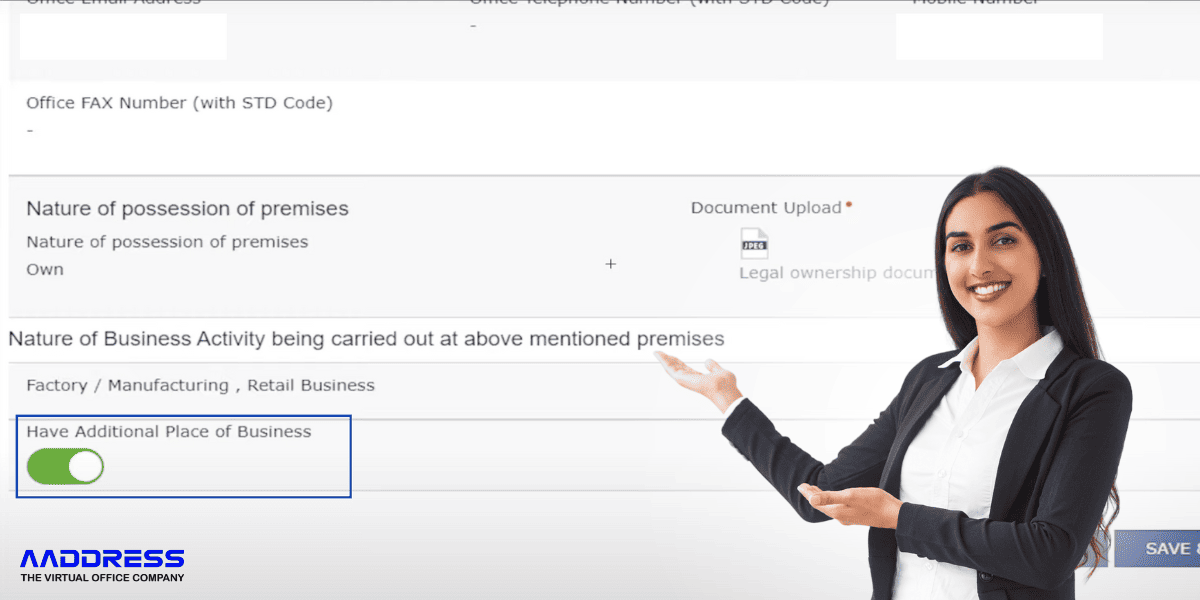Introduction
Do you need help finding the right business idea in a city as dynamic as Chennai? Do high real estate costs, traffic congestion, and stiff competition overwhelm you? These challenges can be daunting for many aspiring entrepreneurs like you, but they also present opportunities to think creatively and start something impactful.
Chennai, often referred to as the cultural capital of South India, is more than just a hub of tradition and heritage. It’s a thriving economic powerhouse, offering vast opportunities for budding entrepreneurs.
If you’re planning to start your venture, the vibrant and diverse market of Chennai provides a fertile ground for small businesses. In this blog, we’ll not only explore small business ideas in Chennai tailored to the city’s vibrant economy and culture but also touch upon how virtual offices can address some of the key problems faced by entrepreneurs.
Why Start a Small Business in Chennai?
Chennai boasts a dynamic economy fueled by sectors like IT, automotive, manufacturing, and tourism. Its steady population growth, skilled workforce, and cosmopolitan culture make it ideal for entrepreneurs. Let’s understand some advantages Chennai offers for small business owners:
- Diverse Demographics: A mix of traditional and modern consumer bases ensures a market for almost any product or service.
- Government Support: Numerous state and central government schemes promote small businesses in Tamil Nadu.
- Accessible Resources: The city has a strong supply chain network, abundant talent, and affordable real estate options.
- Cultural Influence: Events like Pongal, Chennai Sangamam, and music festivals create opportunities for seasonal businesses.
Top Small Business Ideas in Chennai
1. Home-Based Food Services
Why It Works: Chennai residents love their traditional South Indian cuisine, but there’s also a growing demand for international and fusion dishes. Home-based food services, such as tiffin services, catering for small events, or delivering healthy meals, are lucrative.
How to Start:
Invest in quality ingredients and packaging.
Partner with delivery platforms like Swiggy or Zomato.
Market via social media and local WhatsApp groups.
2. Handmade Products and Crafts
Why It Works: Chennai is renowned for its appreciation of arts and crafts. Handmade jewelry, organic skincare products, and home decor items are popular among locals and tourists.
How to Start:
Source eco-friendly materials locally.
Sell on platforms like Etsy, Amazon, or Flipkart.
Showcase at local exhibitions and craft fairs.
3. Fitness and Wellness Services
Why It Works: With increasing health awareness, services like yoga classes, fitness centers, and wellness workshops are in demand. Chennai’s coastal climate also makes outdoor fitness appealing.
How to Start:
Offer beginner-friendly classes.
Collaborate with fitness influencers.
Provide online and offline services for a wider reach.
4. Organic Farming and Farmer’s Markets
Why It Works: Chennai’s growing middle-class population is inclined toward organic and farm-fresh produce. Starting a small organic farm or collaborating with local farmers can be profitable.
How to Start:
Lease agricultural land in the outskirts.
Host weekly farmer’s markets in urban neighborhoods.
Offer subscription-based veggie box deliveries.
5. Eco-Friendly Products Store
Why It Works: The city is moving toward sustainability. Starting a store that sells reusable items like bamboo toothbrushes, cloth bags, and biodegradable packaging has potential.
How to Start:
Collaborate with sustainable product manufacturers.
Market on Instagram with eco-conscious themes.
Focus on local markets and e-commerce platforms.
6. Tech Repair and Services
Why It Works: As an IT hub, Chennai has a significant demand for mobile, laptop, and gadget repair services. With minimal investment, you can offer on-site repair services.
How to Start:
Train in basic and advanced gadget repairs.
Advertise services in IT parks and residential complexes.
Offer quick and affordable solutions.
7. Tourism and Travel Services
Why It Works: Chennai is a gateway to South India’s cultural and natural wonders. A small travel agency offering curated local experiences can attract tourists.
How to Start:
Design packages for temple tours, beach visits, and cultural events.
Collaborate with hotels, transport services, and local guides.
Promote via travel blogs and social media.
8. Education and Tutoring Services
Why It Works: With numerous schools, colleges, and competitive exam aspirants, education services are evergreen. You can offer online or offline classes.
How to Start:
Specialize in subjects like math, coding, or language skills.
Create online courses on platforms like Udemy.
Partner with schools for extracurricular training.
9. Pet Care and Grooming Services
Why It Works: With an increasing number of pet owners in Chennai, pet care services are booming. Pet grooming, boarding, and even boutique pet products have huge potential.
How to Start:
Attend certified pet grooming training.
Open a pet salon or a mobile grooming van.
Offer customized care packages.
10. Event Planning and Management
Why It Works: From traditional weddings to corporate events, Chennai’s diverse population creates a constant need for event planners.
How to Start:
Begin with small birthday parties or family events.
Partner with decorators, caterers, and photographers.
Promote on platforms like Instagram and Pinterest.
11. Real Estate and Rental Services
Why It Works: The booming real estate sector in Chennai provides opportunities for property management, rental services, and real estate consultancy.
How to Start: Specialize in helping students or IT professionals find accommodation. Offer virtual tours of properties. Build a network with builders and landlords.
12. Boutique Clothing Store
Why It Works: Chennai’s love for traditional attire like silk sarees, along with modern fashion trends, makes boutique clothing a lucrative business.
How to Start:
Source unique materials from Kanchipuram and local weavers.
Offer customization services for ethnic and contemporary outfits.
Use Instagram to showcase designs.
13. Digital Marketing Agency
Why It Works: As Chennai’s businesses go digital, there’s a need for marketing agencies specializing in SEO, social media, and branding.
How to Start:
Offer services like website design, content creation, and ad campaigns.
Build a portfolio by collaborating with startups.
Leverage LinkedIn to connect with clients.
14. Coastal Adventure Tourism
Why It Works: Chennai’s proximity to the Bay of Bengal makes it perfect for water sports and coastal tourism activities like scuba diving and boat rides.
How to Start:
Partner with certified diving instructors.
Focus on eco-friendly tourism practices.
Target tourists and local adventure enthusiasts.
15. Freelance Services
Why It Works: Freelancing in fields like content writing, graphic design, and software development is booming. Chennai’s skilled workforce and global client base are a perfect match.
How to Start:
Create a strong online presence on platforms like Upwork and Fiverr.
Build a niche in a specific skill.
Network in Chennai’s co-working spaces.
Tips for Success in Small Business in Chennai
- Understand the Local Market: Conduct thorough research to identify gaps in the market.
- Leverage Digital Platforms: Use social media and e-commerce websites to reach your target audience.
- Focus on Customer Experience: Chennai customers value quality and hospitality.
- Adapt to Trends: Keep an eye on market trends, especially during festivals and events.
- Utilize Government Schemes: Take advantage of MSME loans and Tamil Nadu’s startup initiatives.
Requirements for Starting a Business in Chennai
Starting a business in Chennai is an exciting opportunity, but it’s essential to meet the necessary legal and operational requirements. These steps ensure your business is compliant, efficient, and set up for success. Let’s explore the key aspects in detail:
1. Define Your Business Idea and Plan
Conduct market research to understand the demand for your product or service in Chennai. Create a solid business plan outlining your objectives, budget, revenue model, and marketing strategy.
2. Choose Your Business Structure
- Sole Proprietorship: Suitable for small businesses managed by a single individual.
- Partnership Firm: For ventures involving two or more partners.
- Private Limited Company: Ideal for scalable businesses with growth potential.
- LLP (Limited Liability Partnership): A blend of limited liability and partnership benefits.
- One-Person Company (OPC): For solo entrepreneurs with legal separation from personal assets.
3. Secure a Business Address for Registration
A registered business address is mandatory for setting up any business in Chennai. This address is used for official correspondence and licensing purposes.
- Physical Office Address: Rent or purchase an office space in a commercial area based on your business needs.
- Home Address: If you’re a freelancer or running a small-scale business, you can use your home address (subject to local laws).
- Virtual Office Address: A cost-effective alternative, especially for startups. Virtual offices provide you with a prestigious address in Chennai for registration, mail handling, and other official needs without requiring physical occupancy.
Why is this important? A proper business address enhances your credibility and is essential for compliance with government regulations, GST registration, and opening a business bank account.
4. Obtain Necessary Licenses and Permits
- Register your business with the Ministry of Corporate Affairs (MCA) or as per Tamil Nadu state laws.
- Obtain licenses like Trade License, GST Registration, or FSSAI License (for food-related businesses).
- Comply with specific industry regulations based on your business type.
5. Secure Investment for Your Business
Every business requires capital to cover initial setup costs, inventory, marketing, and operational expenses. Here are the common funding options:
- Self-Funding: Use personal savings or family contributions.
- Bank Loans: Apply for SME loans, startup loans, or government-backed funding schemes like Mudra Yojana.
- Venture Capital or Angel Investors: Seek funding from investors interested in your industry or niche.
- Government Grants and Subsidies: Tamil Nadu offers various incentives for startups and small businesses under its MSME policies.
- Crowdfunding: Leverage online platforms to raise funds from a wider audience.
6. Build an Online Presence
- Create a professional website to showcase your offerings.
- Leverage social media platforms for marketing and customer engagement.
- Register your business on Google My Business to attract local customers.
No Office? No Problem: Why Virtual Offices are a Smart Choice in Chennai
Starting a business in Chennai can be exciting, but one common roadblock for entrepreneurs is finding an office space. High rents in prime locations, long-term leases, and hefty setup costs can put a strain on your budget even before your business takes off. If this sounds like your situation, don’t let it stop you—virtual offices offer the perfect solution!
What is a Virtual Office?
A virtual office allows you to establish a professional business presence without the need for a physical workspace. You get all the benefits of having an office, such as a prime business address, mail handling, and access to meeting rooms, without the burden of renting or maintaining a physical space.
Benefits of a Virtual Office in Chennai
- Cost-Effective: Save money on rent, utilities, and office setup costs.
- Prime Location Advantage: Get a prestigious business address in Chennai’s bustling commercial hubs without paying sky-high rents.
- Flexibility: Operate your business from anywhere while maintaining a professional presence.
- Professional Services: Access administrative support, mail handling, and meeting rooms as needed.
- Perfect for Startups: Ideal for entrepreneurs testing the waters or operating on a lean budget.
How Virtual Offices Solve Key Problems
- Problem: Can’t afford an office in Chennai’s expensive commercial areas.
Solution: A virtual office provides an affordable way to establish your business in premium locations starting at Rs 999/month.
- Problem: Need a professional address to build credibility.
Solution: Use a virtual office address on your business cards, website, and marketing materials.
- Problem: Don’t need a physical workspace but require occasional meeting rooms.
Solution: Many virtual offices offer pay-per-use access to meeting and conference rooms.
Conclusion
Starting a small business in Chennai can be incredibly rewarding if you tap into the city’s rich cultural and economic diversity. Whether you’re passionate about food, technology, or sustainability, there’s a business idea for everyone. By focusing on quality, innovation, and customer satisfaction, you can carve a niche for yourself in this vibrant city.
Are you ready to turn your entrepreneurial dream into reality? Explore these small business ideas, choose the one that suits your skills and interests, and take the first step toward success!


